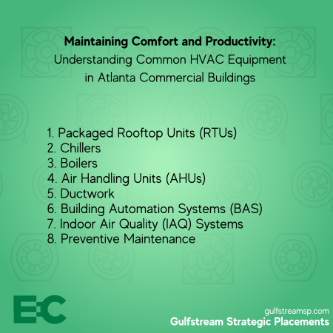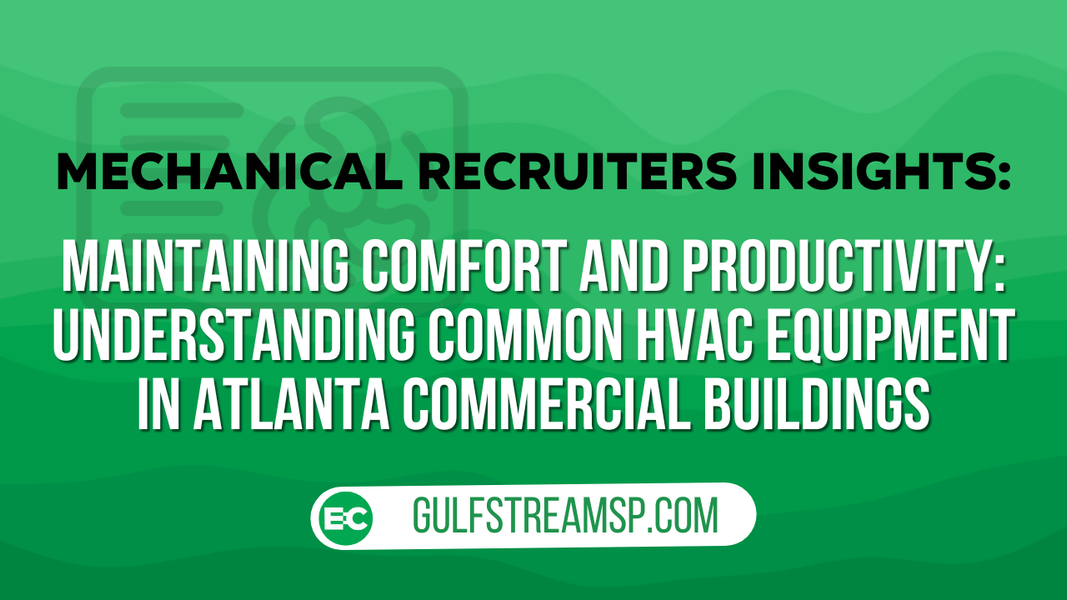Maintaining Comfort and Productivity: Understanding Common HVAC Equipment in Atlanta Commercial Buildings
With its diverse climate and bustling commercial landscape, Atlanta presents unique heating, ventilation, and air conditioning (HVAC) systems challenges. To ensure comfortable and productive work environments, commercial building owners and managers rely on various HVAC equipment, each designed to address specific needs.

1. Packaged Rooftop Units (RTUs)
RTUs are the most common type of HVAC system in commercial buildings, particularly in low-rise structures. These self-contained units, typically on the roof, combine heating, cooling, and ventilation functions into a single package. RTUs are known for their energy efficiency, ease of installation, and relatively low maintenance requirements.
2. Chillers
Chillers are the workhorses of commercial cooling systems, responsible for removing heat from the air and circulating cool air throughout a building. These large, powerful units are often used with RTUs or other air-handling systems to provide year-round comfort. Chillers come in various types, including absorption chillers, centrifugal chillers, and screw chillers, each with its advantages and applications.
3. Boilers
Boilers are the heart of commercial heating systems, generating hot water or steam to distribute heat throughout a building. These systems are essential for maintaining comfortable temperatures during Atlanta's colder months. Boilers come in various types, including gas, oil, and electric boilers, each with its own fuel source and efficiency considerations.
4. Air Handling Units (AHUs)
AHUs are responsible for circulating and conditioning air within a building. They filter, heat, cool, humidify, and dehumidify air as needed, ensuring the indoor environment remains comfortable and healthy. AHUs are often paired with chillers, boilers, or other HVAC systems to provide comprehensive climate control.
5. Ductwork
Ductwork is the network of pipes and ducts that transport conditioned air throughout a commercial building. Properly designed and maintained ductwork is crucial for efficient airflow, ensuring that the HVAC system effectively distributes heating and cooling throughout the building. Regular duct cleaning is essential to prevent the accumulation of dust, mold, and other contaminants that can compromise indoor air quality.
6. Building Automation Systems (BAS)
BAS are intelligent control systems that monitor and manage HVAC equipment throughout a commercial building. These systems collect data from sensors and thermostats, adjusting settings and optimizing performance to maintain comfort, energy efficiency, and overall system health. BAS can also provide valuable insights into energy consumption, allowing for proactive maintenance and cost savings.
7. Indoor Air Quality (IAQ) Systems
IAQ systems maintain healthy indoor air quality by removing pollutants, contaminants, and airborne pathogens. These systems often include air filters, ultraviolet (UV) germicidal lights, and dehumidifiers to address various IAQ concerns. Proper IAQ management is crucial for employee health, productivity, and overall occupant well-being.
8. Preventive Maintenance
Regular preventive maintenance is essential for ensuring the optimal performance and longevity of HVAC equipment in commercial buildings. This includes routine inspections, cleaning, tune-ups, and component replacements as needed. A well-maintained HVAC system operates more efficiently, consumes less energy, and reduces the risk of costly breakdowns.
Conclusion
HVAC equipment maintains comfortable, productive, and healthy environments in Atlanta's commercial buildings. Building owners and managers can make informed decisions to ensure their facilities remain well-conditioned throughout the year by understanding the types of HVAC systems commonly used and the importance of preventive maintenance.



